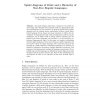25 search results - page 3 / 5 » Formal Concept Analysis-Based Class Hierarchy Design in Obje... |
KBSE
2005
IEEE
13 years 10 months ago
2005
IEEE
Traits are basically mixins or interfaces but with method bodies. In languages that support traits, classes are composed out of traits. There are two main advantages with traits. ...
CSMR
2005
IEEE
13 years 10 months ago
2005
IEEE
Object-oriented applications are difficult to extend and maintain, due to the presence of implicit dependencies in the inheritance hierarchy. Although these dependencies often co...
CACM
1999
13 years 4 months ago
1999
ion suffices ("decide which type you want and provide a full set of operations for each type"). If the application domain is, say, the administration of a university, the...
DIAGRAMS
2008
Springer
13 years 6 months ago
2008
Springer
Abstract. The spider diagram logic forms a fragment of constraint diagram logic and is designed to be primarily used as a diagrammatic software specification tool. Our interest is ...
ADAEUROPE
2000
Springer
13 years 9 months ago
2000
Springer
Saving internal program data for further use is one of the most useful ideas in programming. Developing general features to provide such data saving/ restoring is a very active res...

